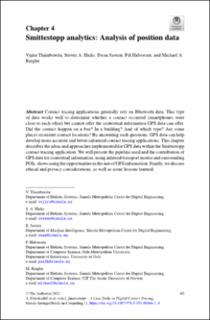| dc.contributor.author | Thambawita, Vajira L B | |
| dc.contributor.author | Hicks, Steven | |
| dc.contributor.author | Ewan, Jaouen | |
| dc.contributor.author | Halvorsen, Pål | |
| dc.contributor.author | Riegler, Michael | |
| dc.date.accessioned | 2022-08-26T13:04:26Z | |
| dc.date.available | 2022-08-26T13:04:26Z | |
| dc.date.created | 2022-06-24T08:36:20Z | |
| dc.date.issued | 2022-06-18 | |
| dc.identifier.isbn | 978-3-031-05465-5 | |
| dc.identifier.isbn | 978-3-031-05466-2 | |
| dc.identifier.issn | 2512-1677 | |
| dc.identifier.issn | 2512-1685 | |
| dc.identifier.uri | https://hdl.handle.net/11250/3013814 | |
| dc.description.abstract | Contact tracing applications generally rely on Bluetooth data. This type of data works well to determine whether a contact occurred (smartphones were close to each other) but cannot offer the contextual information GPS data can offer. Did the contact happen on a bus? In a building? And of which type? Are some places recurrent contact locations? By answering such questions, GPS data can help develop more accurate and better-informed contact tracing applications. This chapter describes the ideas and approaches implemented for GPS data within the Smittestopp contact tracing application. We will present the pipeline used and the contribution of GPS data for contextual information, using inferred transport modes and surrounding POIs, showcasing the opportunities in the use of GPS information. Finally, we discuss ethical and privacy considerations, as well as some lessons learned. | en_US |
| dc.language.iso | eng | en_US |
| dc.publisher | Springer | en_US |
| dc.relation.ispartof | Smittestopp − A Case Study on Digital Contact Tracing | |
| dc.relation.ispartofseries | Simula SpringerBriefs on Computing;Volume 11 | |
| dc.rights | Navngivelse 4.0 Internasjonal | * |
| dc.rights.uri | http://creativecommons.org/licenses/by/4.0/deed.no | * |
| dc.subject | Smittestopp | en_US |
| dc.subject | Position data | en_US |
| dc.subject | GPS data | en_US |
| dc.subject | Data analyses | en_US |
| dc.subject | Contact tracing | en_US |
| dc.subject | Infection control | en_US |
| dc.title | Smittestopp analytics: Analysis of position data | en_US |
| dc.type | Chapter | en_US |
| dc.type | Peer reviewed | en_US |
| dc.description.version | publishedVersion | en_US |
| dc.rights.holder | © The Author(s) 2022 | en_US |
| cristin.ispublished | true | |
| cristin.fulltext | original | |
| cristin.qualitycode | 1 | |
| dc.identifier.doi | https://doi.org/10.1007/978-3-031-05466-2_4 | |
| dc.identifier.cristin | 2034701 | |
| dc.source.journal | Simula SpringerBriefs on Computing | en_US |
| dc.source.volume | 11 | en_US |
| dc.source.issue | 11 | en_US |
| dc.source.pagenumber | 63-79 | en_US |

